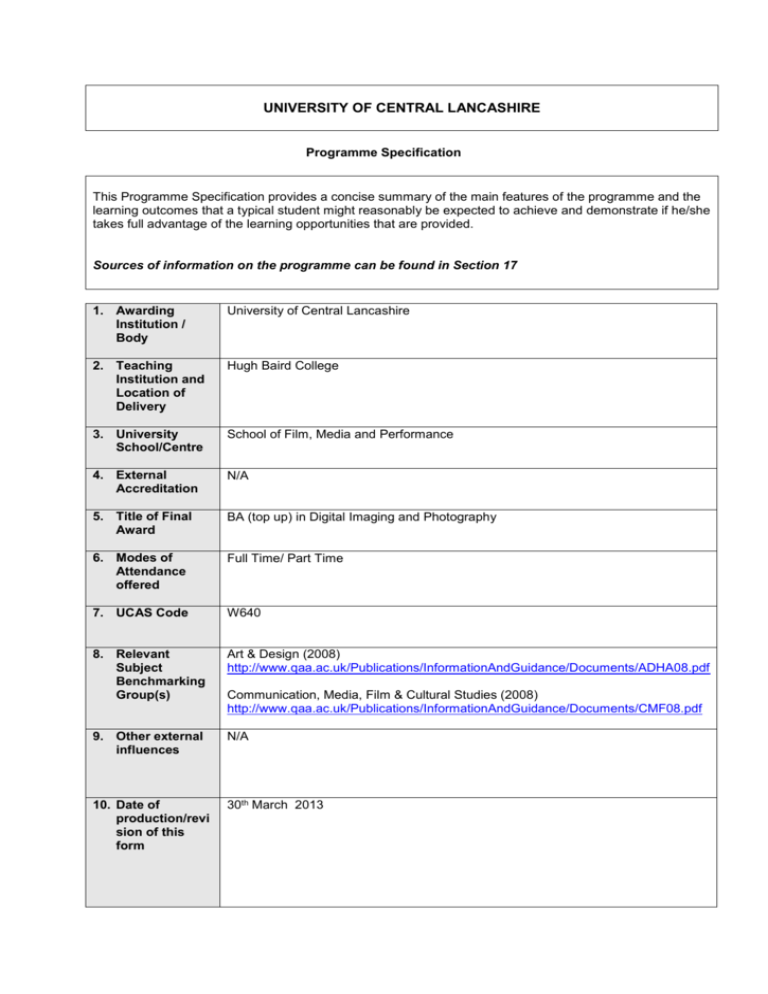BA (Hons) Digital Imaging and Photography
advertisement

UNIVERSITY OF CENTRAL LANCASHIRE Programme Specification This Programme Specification provides a concise summary of the main features of the programme and the learning outcomes that a typical student might reasonably be expected to achieve and demonstrate if he/she takes full advantage of the learning opportunities that are provided. Sources of information on the programme can be found in Section 17 1. Awarding Institution / Body University of Central Lancashire 2. Teaching Institution and Location of Delivery Hugh Baird College 3. University School/Centre School of Film, Media and Performance 4. External Accreditation N/A 5. Title of Final Award BA (top up) in Digital Imaging and Photography 6. Modes of Attendance offered Full Time/ Part Time 7. UCAS Code W640 8. Relevant Subject Benchmarking Group(s) Art & Design (2008) http://www.qaa.ac.uk/Publications/InformationAndGuidance/Documents/ADHA08.pdf 9. Other external influences N/A 10. Date of production/revi sion of this form 30th March 2013 Communication, Media, Film & Cultural Studies (2008) http://www.qaa.ac.uk/Publications/InformationAndGuidance/Documents/CMF08.pdf 11. Aims of the Programme To allow students to build upon previous level 4 and 5 qualifications or industrial experience to further widen participation in higher education and develop their ability to produce innovative work of high quality with an awareness of professional level requirements and expectations To provide the framework to support students to build on their strengths and interests and to further develop these in sufficient depth to provide a sound grounding for professional and/or postgraduate work To guide students to acquire further knowledge and understanding, develop personal attributes and master essential technical and transferable skills so that they are able to work independently in the photography / digital imaging sector or other related areas To develop students’ academic and research skills where appropriate, preparing them for study at Master’s level and expand their experiences and outlook in relation to the world of professional creativity 12. Learning Outcomes, Teaching, Learning and Assessment Methods A. Knowledge and Understanding at level 6 A3.1) Create professional level photographic/digital imaging work in practical and critical terms Teaching and Learning Methods Knowledge and Understanding at level 6 is characterised by a synthesis of the relationships between theory and practice, intention and technical realisation. Learning situations include: Lectures Seminars and discussion groups Practical tutor – led workshops Group tutorials, peer review and formative verbal feedback One-to-one tutorials Study visits Assessment methods At this level the following activities are used for assessment: Practical work Research and development work Presentations Written assignments B. Subject-specific skills at level 6 B3.1) Independently produce a body of work suitable for public exhibition / distribution B3.2) Create work with a well developed understanding of the medium of photography and digital imaging in technical, contextual and critical terms B3.3) Demonstrate the ability to extend an argument and show a substantial degree of critical judgment with respect to the topic being researched and written about B3.4) Demonstrate an ability to produce a sustained piece of writing using appropriate scholarly apparatus and conventions B3.5) Undertake appropriate research using both primary and secondary source material B3.6) Demonstrate an ability to originate and plan an appropriate academic project Teaching and Learning Methods Practical study occurs within: Analysis of contemporary and historical theory and practice Workshops Tutorials Lecture Exhibitions/publications Self-reflection and peer group evaluation Assessment methods At this level the following activities are used for assessment: Practical work Research and development work Presentations C. Thinking Skills at level 6 C3.1) Demonstrate the ability to undertake critical reflection on their learning C3.2) Generate, develop and evaluate ideas independently C3.3) Use appropriate critical, analytical, theoretical and methodological approaches to a chosen topic Teaching and Learning Methods Thinking skills within this course are the intellectual qualities related to cognitive ability through the acquisition of critical and contextual knowledge. The application of these qualities occurs in all teaching and learning situations and at this level these are focussed upon the evaluation of critical ideas within a variety of contexts and the ability to create original product. At this level it is expected that students should apply techniques that define the thinking performer and the reflective practitioner. Assessment methods At this level the following activities are used for assessment: D. Practical work Written assignments Presentations Other skills relevant to employability and personal development at level 6 D3.1) Demonstrate an ability to work independently on a sustained piece of academic work D3.2) Create work with professional standards of production and presentation within resource constraints D3.3) Independently research a chosen area of the photographic industry in depth and breadth from secondary and, where appropriate, primary sources D3.4) Respond actively to guidance and feedback D3.5 Demonstrate personal effectiveness in a selection process of a specified chosen career Teaching and Learning Methods Outcomes within this category at level 6 are designed to bring to maturity the transition from study to workplace. They relate to the ability to administrate, manage and evaluate individual projects. Learning at level 6 should be independent and determined by self-devised goals and stimuli. Assessment methods At this level the following activities are used for assessment: Practical work Research and development work Presentations Written assignments 13. Programme Structures* Level Module Code PDI3200 DD3000 Level 6 PH3010 PH3011 PDI3075 DD3992 Module Title Dissertation (Elective) Contextual Studies (Design Futures) (Elective) Portfolio Development Professional Development Responsive Module Honours Project 14. Awards and Credits* Credit rating 20 20 20 20 20 40 Bachelor Honours Degree Requires 360 credits including a minimum of 220 at Level 5 and 100 at Level 6 Bachelor Degree Requires 320 credits including a minimum of 180 at Level 5 and 40 at Level 6 15. Personal Development Planning At his level, with minor support, you should be taking responsibility for your own learning and career development and able to evaluate your strengths, weaknesses and progression. The BA Hons 'top up' course is designed to allow students to choose or negotiate many aspects of their learning in ways which are appropriate to their abilities, learning preferences and vocational intentions. PDP is designed to enable you to work towards a point where would like to be on graduation; to help you acquire the skills needed for your chosen career; evaluate your strengths and plan to deploy them in a range of situations after graduation. Your personal aspirations will form the basis of project work and planning and the modules D3992 and PH3011 are specifically designed to develop professional practice and appropriate career ambitions 16. Admissions criteria Programme Specifications include minimum entry requirements, including academic qualifications, together with appropriate experience and skills required for entry to study. These criteria may be expressed as a range rather than a specific grade. Amendments to entry requirements may have been made after these documents were published and you should consult the University’s website for the most up to date information. Students will be informed of their personal minimum entry criteria in their offer letter. Entry on to this course is through interview with portfolio of work. Additionally we will normally expect applicants to have the following qualifications: Successful completion of the Foundation Degree in Digital Imaging and Photography or equivalent Art, Design or Media-related Foundation Degrees which have a significant digital imaging or photographic content. Some students may be required to undertake a bridging module. A transcript may be required. or Successful completion of an Art, Design or Media related HND which has significant digital imaging or photography content. Some students may be required to undertake a bridging module. Overseas students overseas students are welcome to apply with evidence of relevant and equivalent qualifications and portfolio as stated for all external applicants Students will also need to provide evidence of English Language entry requirements (IELTS level 6). 17. Key sources of information about the programme Hugh Baird College Website - http://www.hughbaird.ac.uk/Course/photography-and-digitalimaging-foundation-degree Course Tutor: David Lockwood Hugh Baird College Higher Education Prospectus http://issuu.com/hughbaird1/docs/4464_hb_he_prospectus_1__final_single_page?mode=windo w&backgroundColor=%23222222 UCAS: http://www.ucas.ac.uk Course Fact Sheet Student Handbook LEVEL 6 Note: PDI3200 Dissertation DD3000 Contextual Studies – Design Futures DD3992 Honours Project PH3010 Portfolio Development D3.5 D3.4 D3.3 D3.2 D3.1 C3.1 B3.6 B3.5 B3.4 B3.3 C3.3 Other skills relevant to Thinking Skills employability and personal development Subject-specific Skills C3.2 Knowledg e and understan ding B3.2 Module Title B3.1 Module Code A3.1 Level Core (C), Compulsory (COMP) or Option (O) 18. Curriculum Skills Map Please tick in the relevant boxes where individual Programme Learning Outcomes are being assessed Programme Learning Outcomes O x x x x x x x x x O x x x x x x x x x x x x x x x x CORE x x x x COMP x x PH3011 Professional Development COMP x x x PDI3075 Responsive Module COMP x x x x x x x x x x x x x x x x x x x x x x Mapping to other external frameworks, e.g. professional/statutory bodies, if applicable, will be included within Student Course Handbooks









